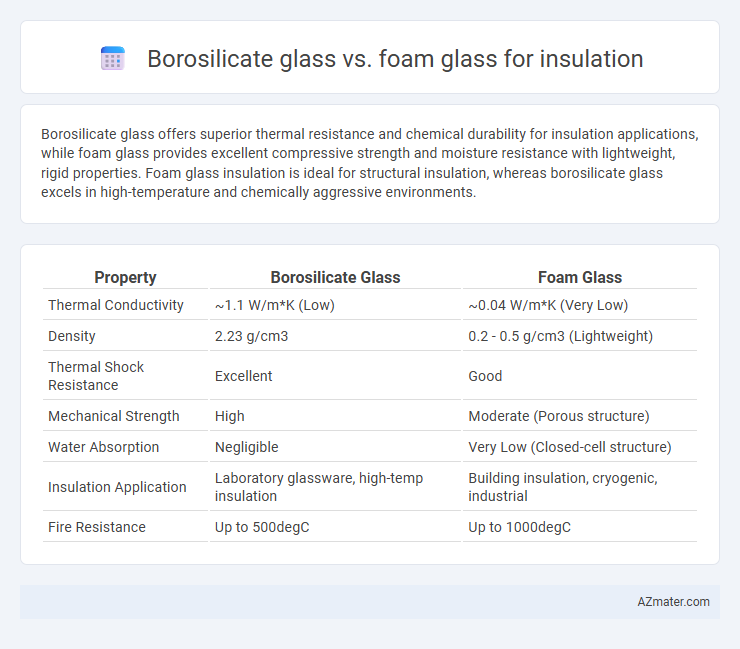Borosilicate glass offers superior thermal resistance and chemical durability for insulation applications, while foam glass provides excellent compressive strength and moisture resistance with lightweight, rigid properties. Foam glass insulation is ideal for structural insulation, whereas borosilicate glass excels in high-temperature and chemically aggressive environments.
Table of Comparison
| Property | Borosilicate Glass | Foam Glass |
|---|---|---|
| Thermal Conductivity | ~1.1 W/m*K (Low) | ~0.04 W/m*K (Very Low) |
| Density | 2.23 g/cm3 | 0.2 - 0.5 g/cm3 (Lightweight) |
| Thermal Shock Resistance | Excellent | Good |
| Mechanical Strength | High | Moderate (Porous structure) |
| Water Absorption | Negligible | Very Low (Closed-cell structure) |
| Insulation Application | Laboratory glassware, high-temp insulation | Building insulation, cryogenic, industrial |
| Fire Resistance | Up to 500degC | Up to 1000degC |
Introduction to Borosilicate Glass and Foam Glass
Borosilicate glass, known for its exceptional thermal resistance and low thermal expansion, is widely used in insulation applications requiring durability under high temperatures. Foam glass, created by fusing crushed glass with a foaming agent, offers superior insulation through its closed-cell structure that traps air and provides excellent moisture resistance. Both materials serve distinct insulation needs, with borosilicate glass excelling in chemical and thermal stability, while foam glass is preferred for lightweight, moisture-resistant thermal barriers.
Composition and Manufacturing Processes
Borosilicate glass is composed primarily of silica and boron trioxide, manufactured through melting and controlled cooling processes that enhance thermal resistance and durability. Foam glass consists of crushed glass powder mixed with a foaming agent, heated to create a porous, lightweight structure ideal for insulation. The manufacturing process for foam glass involves sintering the mixture at high temperatures, resulting in a cellular glass material with excellent thermal insulation and moisture resistance.
Thermal Insulation Properties
Borosilicate glass offers superior thermal insulation due to its low thermal conductivity and high resistance to thermal shock, making it ideal for applications requiring temperature stability and durability. Foam glass insulation provides excellent thermal resistance through its cellular structure, which traps air and reduces heat transfer efficiently while also offering moisture resistance and compressive strength. Both materials excel in thermal insulation, but borosilicate glass is preferred for high-temperature environments, whereas foam glass is advantageous for structural insulation with moisture control.
Mechanical Strength and Durability
Borosilicate glass offers superior mechanical strength with high resistance to thermal shock and mechanical impact, making it ideal for demanding insulation applications. Foam glass provides excellent compressive strength and long-term durability, combined with low permeability to moisture and chemicals, enhancing its effectiveness in harsh environments. Both materials exhibit robust durability, but borosilicate glass excels in toughness, while foam glass is advantageous for structural insulation due to its lightweight and resistance to degradation.
Resistance to Chemical and Water Exposure
Borosilicate glass offers excellent resistance to chemical corrosion and water exposure due to its low thermal expansion and high chemical inertness, making it ideal for harsh environments. Foam glass provides good water resistance with its closed-cell structure, preventing moisture absorption, but may be less durable against aggressive chemicals compared to borosilicate glass. Both materials excel in insulation, yet borosilicate glass maintains superior performance under prolonged chemical and water exposure.
Fire and Temperature Resistance
Borosilicate glass exhibits superior fire and temperature resistance due to its low thermal expansion coefficient and ability to withstand temperatures up to 1200degC without deforming or releasing harmful fumes. Foam glass, while providing excellent thermal insulation and fire resistance with non-combustible properties, typically endures temperatures up to 700degC before structural integrity diminishes. The high melting point and thermal shock resistance of borosilicate glass make it more suitable for applications requiring extreme heat tolerance compared to foam glass insulation.
Environmental Impact and Sustainability
Borosilicate glass features high durability and recyclability, reducing environmental impact through repeated reuse and resistance to thermal shock, making it a sustainable choice for insulation. Foam glass insulation, made from recycled glass and exhibiting excellent thermal performance and moisture resistance, offers superior sustainability by minimizing waste and enhancing energy efficiency. Both materials contribute to eco-friendly building practices, with foam glass often favored for its closed-cell structure and lower environmental footprint in insulation applications.
Application Areas and Use Cases
Borosilicate glass excels in laboratory and high-temperature applications due to its thermal shock resistance and chemical durability, commonly used in scientific equipment and cookware. Foam glass offers superior thermal and sound insulation for construction, including insulating walls, roofs, and floors in industrial and residential buildings. Both materials serve insulation purposes, but borosilicate glass is preferred for precision in scientific environments, while foam glass is favored for structural and energy-efficient building solutions.
Cost Comparison and Economic Considerations
Borosilicate glass insulation typically incurs higher initial costs due to its superior thermal resistance and durability, making it suitable for high-performance applications despite the upfront expense. Foam glass, by contrast, offers a more cost-effective solution with lower production costs and excellent insulating properties, contributing to reduced long-term energy expenses. Economic considerations favor foam glass for large-scale or budget-sensitive projects, while borosilicate glass provides value in scenarios requiring enhanced thermal stability and chemical resistance.
Choosing the Right Insulation: Borosilicate vs Foam Glass
Borosilicate glass excels in thermal stability and resistance to thermal shock, making it ideal for environments with rapid temperature fluctuations. Foam glass offers superior compressive strength and moisture resistance, providing effective insulation in damp or load-bearing applications. Selecting between borosilicate and foam glass depends on specific insulation needs such as thermal performance, structural demands, and exposure to moisture.

Infographic: Borosilicate glass vs Foam glass for Insulation
 azmater.com
azmater.com